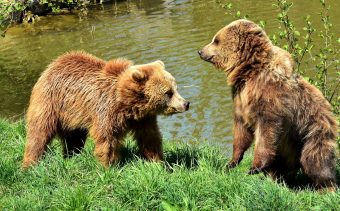
The number of negative news about large carnivores in Slovak media is increasing. For that reason, representatives of WWF Slovakia in cooperation with WWF Adria brought Slovak bear experts to Croatia to show them examples of successful human and large carnivores coexistence.
Representatives of the Slovak Agency for nature protection, bear intervention team from Slovakia and Slovak journalists had a chance to visit Kuterevo Bear Refuge, Risnjak National Park and surrounding places, where they could hear personal stories and experiences of residents of Lika and Gorski kotar.
Romana Uhrinova from WWF Slovakia points out that the number of bears in Slovakia is similar to the bear population in Croatia.
“Fake news about bear attacks cause fear in our people, which leads to conflicts and makes it much more difficult to sustainably manage this species, which is very important for our forest ecosystems. We came to Kuterevo to find out how local people manage to live with bears without conflicts and how a bear refuge can help in raising awareness about their importance. We believe that we can use this Croatian example as a basis for positive change in our country”, concludes Uhrinova.
Brown bear is permanently present in Croatia in an area larger than 10,000 km2. The increase in human population has inevitably reduced the bears’ living space, and their population has drastically dropped. However, new hunting regulations introduced in the mid-20th century have led to growth and stabilization of the bear population, even though risks, such as habitat fragmentation, poaching and conflicts with people still exist.
More:
“The residents of Kuterevo make a great example of establishing a successful coexistence with the bear population. Not only have they almost completely adapted to coexistence, but their bear refuge also brings them visitors from all over Croatia and beyond, which brings income to locals and contributes to the development of the village. The refuge can almost be called a bear embassy, where it is possible to see bears up close, but also learn all about the problems associated with their wild relatives”, said Neven Šlopar from WWF Adria.
Besides Kuterevo, WWF Adria‘s guests also visited Risnjak National Park where, with the expert guidance of a nature conservationist, they crossed the Leska educational path and saw the settlement for rehabilitation of lost lynx cubs. They also visited the only Croatian Large Carnivores Visitor Center in Stara Sušica, where they could hear interesting information about coexistence of people and large carnivores in Gorski kotar.
“Despite the challenges that the presence of large carnivores can create for local communities, we are convinced that we have managed to bring closer the positive aspects of coexistence in Croatia to our Slovak colleagues, including real benefits that enable local people to live in harmony with nature”, concludes Šlopar.
The visit is organized as part of LIFE EuroLargeCarnivores project, which aims to improve human coexistence with large carnivores in Europe through awareness raising and transboundary cooperation in 16 European countries.
Source: WWF Adria



